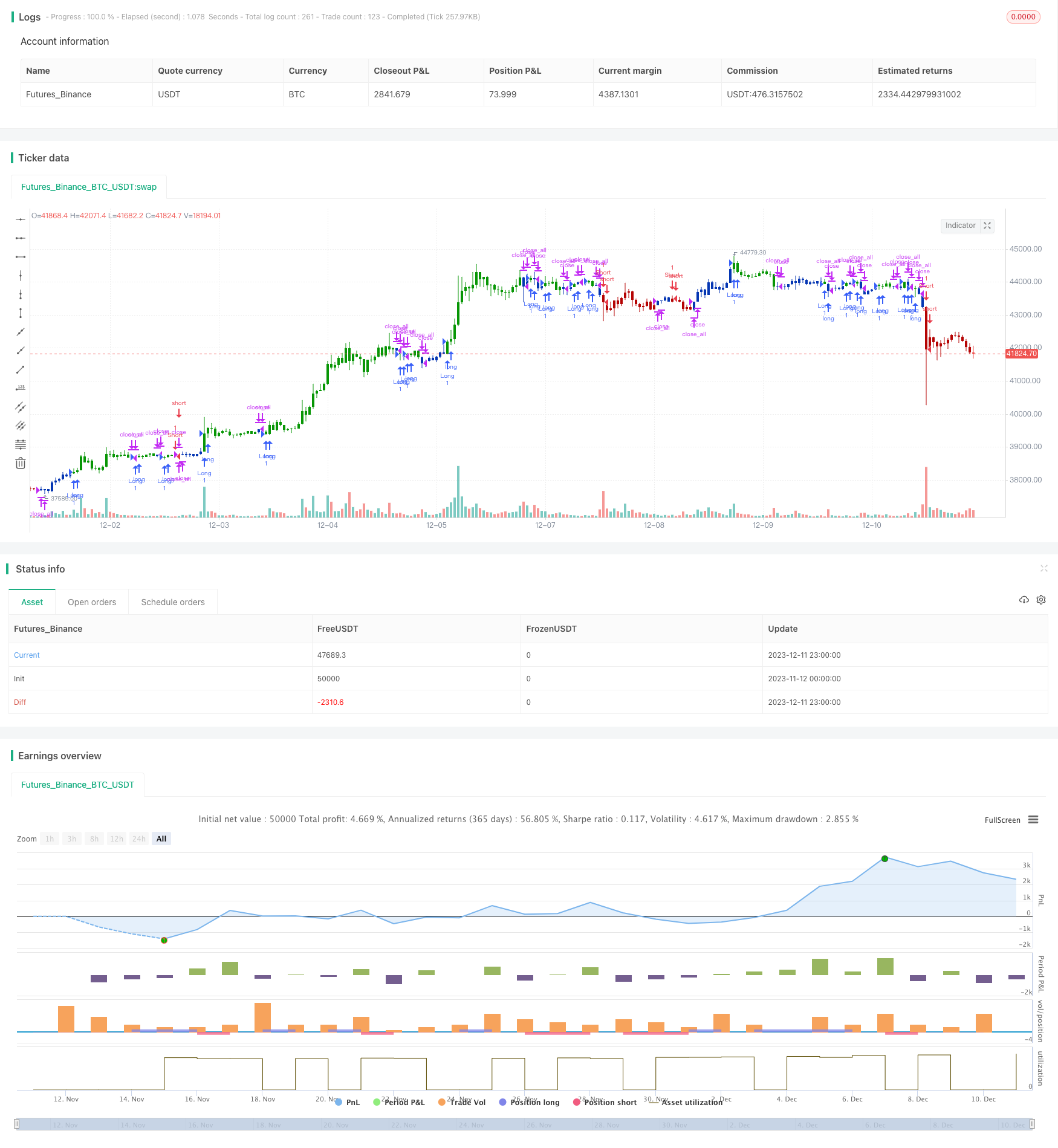
概述
这是一个结合双重反转信号的趋势跟踪策略。它整合了123反转策略和性能指数策略,追踪价格反转点,实现更可靠的趋势判断。
策略原理
该策略由两个子策略组成:
123反转策略
使用14日K线判断反转信号。具体规则是:
- 多头信号:前两日收盘价下跌,当前K线收盘价高于前一日收盘价,9日Stochastic Slow低于50
- 空头信号:前两日收盘价上涨,当前K线收盘价低于前一日收盘价,9日Stochastic Fast高于50
性能指数策略
计算过去14日的涨跌幅作为指标。规则如下:
- 性能指数>(0),产生多头信号
- 性能指数<(0),产生空头信号
最终信号是两种信号的综合。即需要同向的多空信号才会产生实际的买卖操作。
这样可以过滤掉部分噪音,使得信号更加可靠。
策略优势
这种双重反转系统有以下优势:
- 结合双重因素判断,信号更加可靠
- 能够有效过滤市场噪音,避免假信号
- 123形态经典且实用,容易判断和复现
- 性能指数能够判断未来趋势走向
- 参数组合灵活,可进一步优化
策略风险
该策略也存在一些风险:
- 可能错过突发性反转,无法全面捕捉趋势
- 双重条件组合导致信号变少,可能影响盈利能力
- 需要同向判断,容易受到个股特殊波动的影响
- 参数设置问题可能导致信号偏差
可以考虑以下几个方面的优化:
- 调整参数,如K线长度、Stochastic周期等
- 优化双重信号的判断逻辑
- 结合更多因子,如成交量等
- 增加止损机制
总结
该策略整合双重反转判断,能有效发现价格转折点。虽然信号发生概率降低,但可靠性较高,适合捕捉中长线趋势。可以通过参数调整和多因子优化进一步增强策略效果。
策略源码
/*backtest
start: 2023-11-12 00:00:00
end: 2023-12-12 00:00:00
period: 1h
basePeriod: 15m
exchanges: [{"eid":"Futures_Binance","currency":"BTC_USDT"}]
*/
//@version=4
////////////////////////////////////////////////////////////
// Copyright by HPotter v1.0 15/04/2021
// This is combo strategies for get a cumulative signal.
//
// First strategy
// This System was created from the Book "How I Tripled My Money In The
// Futures Market" by Ulf Jensen, Page 183. This is reverse type of strategies.
// The strategy buys at market, if close price is higher than the previous close
// during 2 days and the meaning of 9-days Stochastic Slow Oscillator is lower than 50.
// The strategy sells at market, if close price is lower than the previous close price
// during 2 days and the meaning of 9-days Stochastic Fast Oscillator is higher than 50.
//
// Second strategy
// The Performance indicator or a more familiar term, KPI (key performance indicator),
// is an industry term that measures the performance. Generally used by organizations,
// they determine whether the company is successful or not, and the degree of success.
// It is used on a business’ different levels, to quantify the progress or regress of a
// department, of an employee or even of a certain program or activity. For a manager
// it’s extremely important to determine which KPIs are relevant for his activity, and
// what is important almost always depends on which department he wants to measure the
// performance for. So the indicators set for the financial team will be different than
// the ones for the marketing department and so on.
//
// Similar to the KPIs companies use to measure their performance on a monthly, quarterly
// and yearly basis, the stock market makes use of a performance indicator as well, although
// on the market, the performance index is calculated on a daily basis. The stock market
// performance indicates the direction of the stock market as a whole, or of a specific stock
// and gives traders an overall impression over the future security prices, helping them decide
// the best move. A change in the indicator gives information about future trends a stock could
// adopt, information about a sector or even on the whole economy. The financial sector is the
// most relevant department of the economy and the indicators provide information on its overall
// health, so when a stock price moves upwards, the indicators are a signal of good news. On the
// other hand, if the price of a particular stock decreases, that is because bad news about its
// performance are out and they generate negative signals to the market, causing the price to go
// downwards. One could state that the movement of the security prices and consequently, the movement
// of the indicators are an overall evaluation of a country’s economic trend.
//
// WARNING:
// - For purpose educate only
// - This script to change bars colors.
////////////////////////////////////////////////////////////
Reversal123(Length, KSmoothing, DLength, Level) =>
vFast = sma(stoch(close, high, low, Length), KSmoothing)
vSlow = sma(vFast, DLength)
pos = 0.0
pos := iff(close[2] < close[1] and close > close[1] and vFast < vSlow and vFast > Level, 1,
iff(close[2] > close[1] and close < close[1] and vFast > vSlow and vFast < Level, -1, nz(pos[1], 0)))
pos
PI(Period) =>
pos = 0.0
xKPI = (close - close[Period]) * 100 / close[Period]
pos := iff(xKPI > 0, 1,
iff(xKPI < 0, -1, nz(pos[1], 0)))
pos
strategy(title="Combo Backtest 123 Reversal & Perfomance index", shorttitle="Combo", overlay = true)
line1 = input(true, "---- 123 Reversal ----")
Length = input(14, minval=1)
KSmoothing = input(1, minval=1)
DLength = input(3, minval=1)
Level = input(50, minval=1)
//-------------------------
line2 = input(true, "---- Perfomance index ----")
Period = input(14, minval=1)
reverse = input(false, title="Trade reverse")
posReversal123 = Reversal123(Length, KSmoothing, DLength, Level)
posPI = PI(Period)
pos = iff(posReversal123 == 1 and posPI == 1 , 1,
iff(posReversal123 == -1 and posPI == -1, -1, 0))
possig = iff(reverse and pos == 1, -1,
iff(reverse and pos == -1 , 1, pos))
if (possig == 1 )
strategy.entry("Long", strategy.long)
if (possig == -1 )
strategy.entry("Short", strategy.short)
if (possig == 0)
strategy.close_all()
barcolor(possig == -1 ? #b50404: possig == 1 ? #079605 : #0536b3 )